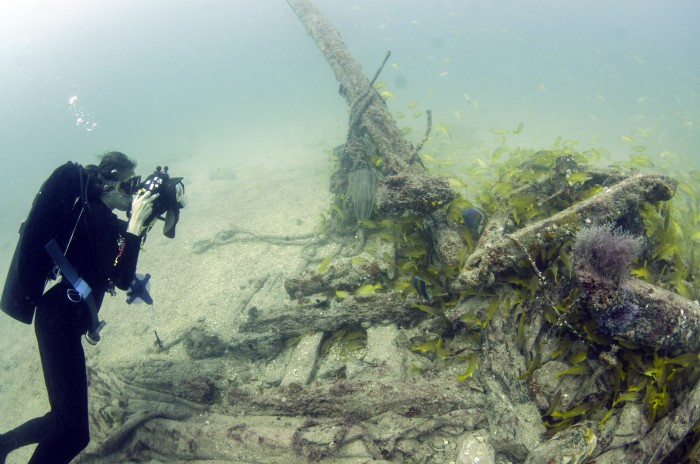The MAT dive team are in Qatar this week to continue work on the QatarMAP project. A series of bad luck with regard to weather, and a breakdown of the air conditioning on the research vessel Janan, prevented the ship sailing early in the week. With the vessel alongside and temperatures around 40 degrees on board, the team sweated their way through the first day, testing and checking geophysical and dive equipment and continued processing of data from the previous week’s diving in Qatar. At a meeting with an expat dive operator that evening, it was confirmed that due to conversion of different coordinate systems, many of the positions for the wrecks were not always reliably.

Approaching Janan after a dive
Then, a sudden break in the weather, and with the AC ‘partially’ fixed, the team made a dash to leave port on the evening of the 23 May. In less than ideal temperatures on board, the evening saw a 3 hour sail followed by a couple of hours of multibeam survey to ensure that the position of the wreck was correct to guarantee divers would land on it the next morning. At first light, divers loaded dive gear from Janan onto the small tender and dropped into the water to be rewarded by a breath-taking dive on a wooden dhow which still presented a lot of structure, (a dhow is a traditional sailing vessel, usually an Arab vessel found in the Red Sea and Indian Ocean, with lateen sails and one or two masts). Photogrammetry and calibration measurements were carried out by the dive team, and following charging of cameras and lights, a further dive was warranted to ensure the production of a spectacular 3D model of such an amazing example of a traditional wooden shipwreck to enhance the maritime historical environmental record in Qatar.

Photographing the wreck
Further multibeam survey took place as temperatures increased onboard the vessel, and a third dive of the day in fading light, was on a charted wreck listed as danger (probably to shipping and therefore unable to sail Janan over it for confirmation with the multibeam). After a circular search of more than 50m out without success, the team came under attacked from a swarm of jellyfish that appeared while they were undertaking a safety stop on return to the surface. Multibeam survey continued into the night to explore the seabed and the temperatures rose as the AC continued to fail. First light saw the dive team off to dive another possible position for the unsuccessful location of the previous days charted wreck site, but the increasing Shamal wind was affecting sea conditions making diving dangerous as the swell tossed the small dive boat around, and concerns also grew about the safe transfer of personnel and equipment back to Janan. A quick ‘dip’ down the shot line by a diver on communications confirmed that the wreck was not in this position either, but this still serves an important purpose by confirming that the wreck is not in the charted position and can be reported to the relevant authorities which will help when they issue their chart corrections.

Diver at the stem post
The weather was closing in as multibeam survey continued, exploring a seabed depression for its potential to contain preserved archaeological material in deeper sedimentary deposits. ‘Sauna’ like conditions now prevailed on the bridge and on the working deck, and members of the team also continued the task of diagnosing the faults on the ROV (remotely operated vehicle). With Janan finally safely back alongside in Doha, the ROV was deployed into the water for a successful trial flight, this is another tool that could be used help with future investigations.
The AC on the vessel is now completely defunct and the weather has broken down again so the team continue to work on post-processing of data collected to produce an exciting 3D model of the dhow and produce a report of the very productive visit before returning to the UK at the weekend.